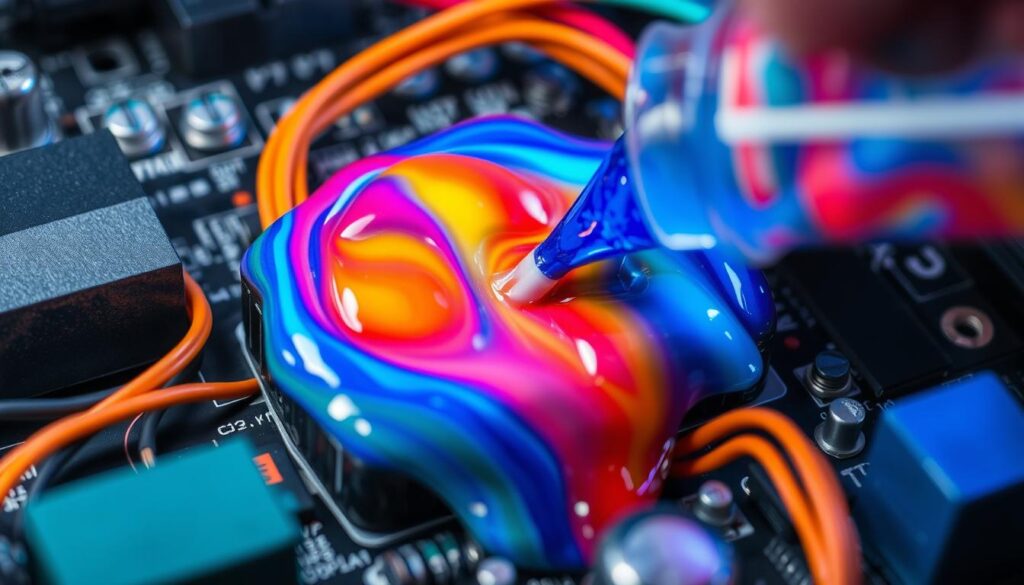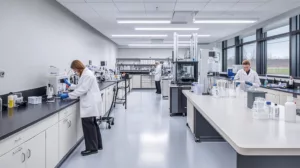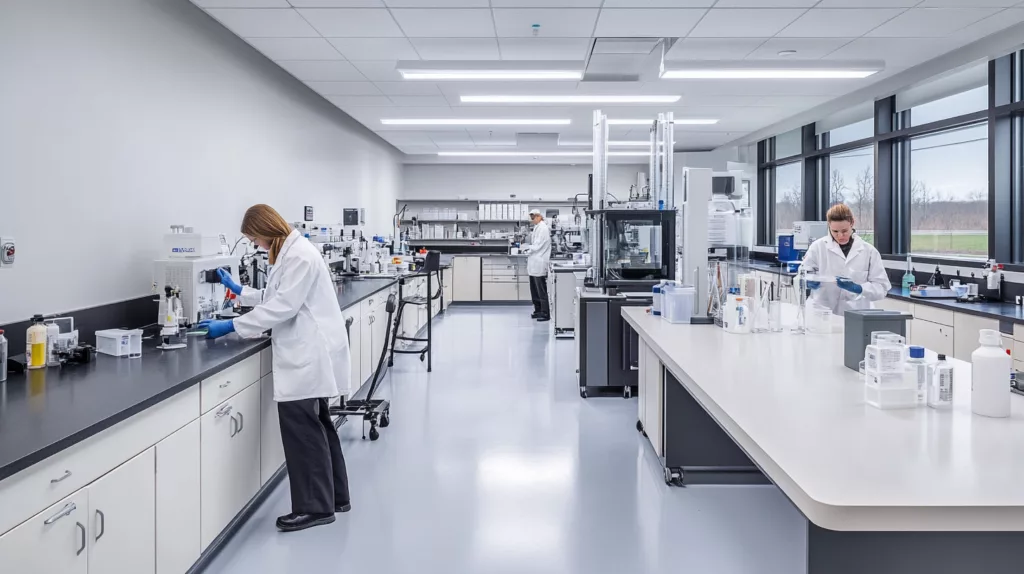Protecting electronic parts from harsh environments is key for makers and engineers. Potting compounds are a top choice for this task. They act as a shield against many environmental dangers. This guide will look into how well these materials handle voltage, their use in high-voltage tech, and what affects their performance.
Potting compounds are vital for keeping electronic circuits safe. They shield against moisture, vibrations, and extreme temperatures. By wrapping around these sensitive parts, they offer electrical protection, mechanical support, and help manage heat. This ensures that the electronics they protect work well for a long time.
Key Takeaways
- Potting compounds provide essential electrical insulation and environmental protection for electronic components.
- The voltage insulation capabilities of potting materials vary based on their chemical composition and properties.
- Understanding the factors that influence voltage insulation, such as temperature and chemical resistance, is critical in choosing the right potting compound.
- Industry standards and testing methods ensure the safety and reliability of potting compounds in high-voltage applications.
- Proper selection and application of potting compounds can improve the performance and lifespan of electronic devices in tough environments.
Understanding Potting Glue Insulation Fundamentals
Potting glue is key to protecting electronic parts from harsh conditions. It keeps them safe from the outside world. Let’s look at how potting glue works and why it’s important for keeping electronics safe.
Basic Components of Potting Compounds
Potting compounds mix several important parts together. These include:
- Epoxy resins – They give the glue strength and stickiness
- Dielectric fillers – These boost the glue’s ability to resist electricity
- Curing agents – They help the glue harden and set
- Additives – These improve the glue’s heat resistance and more
Chemical Properties and Composition
The makeup of potting compounds is carefully crafted. It balances strength, dielectric strength, and insulation resistance. Epoxy resins, for example, help block electrical current. Special fillers also help the material handle high voltages better.
Role in Electrical Protection
Potting glue keeps sensitive parts safe from the outside. It wraps them in a protective layer. This layer guards against moisture, dust, and other dangers. It helps high-voltage electronics work well and last longer.
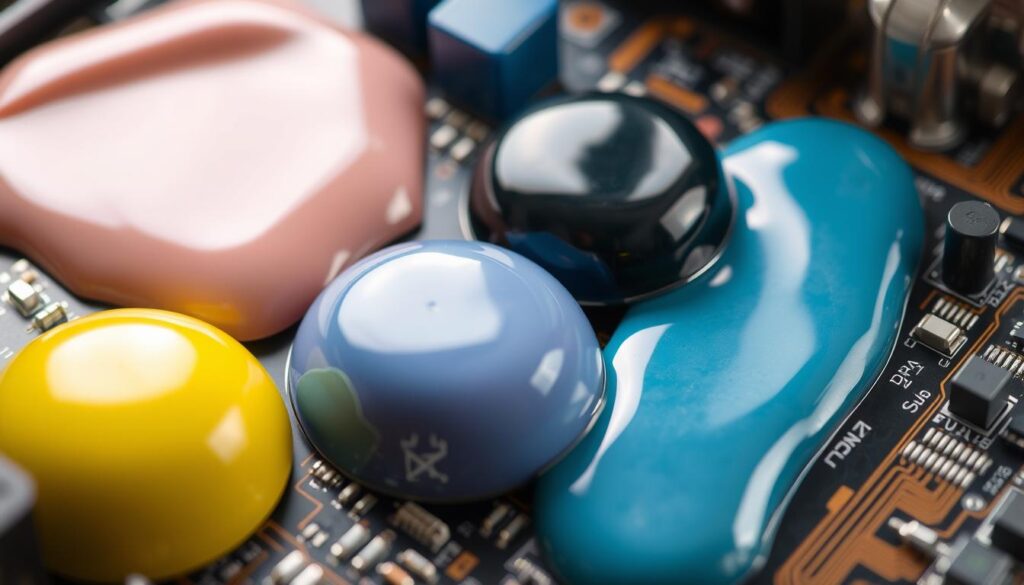
“Potting glue insulation is the unsung hero of modern electronics, quietly ensuring that our devices continue to function flawlessly, even in the face of the harshest conditions.”
How Many Volts Can Be Insulated by Potting Glue Insulation
Potting glue insulation can handle a wide range of voltages. It works for both low-voltage electronics and high-power systems. The voltage breakdown ratings of these materials can go up to several thousand volts. This ensures strong electrical protection for many uses.
The voltage range of potting glue insulation depends on the glue’s chemical makeup. Things like dielectric strength, thermal stability, and resistance to the environment play a big role. By picking the right potting materials, makers can adjust the voltage range for their devices.
- Epoxy-based potting compounds can usually handle voltages up to 5,000 volts.
- Silicone-based potting materials can withstand voltages up to 8,000 volts.
- Polyurethane potting solutions can insulate voltages between 3,000 and 6,000 volts.
The actual voltage breakdown ratings can change based on the specific mix, how it’s used, and the environment. Talking to a trusted maker or expert can help find the best potting compound for your system’s voltage needs.
“Choosing the right potting glue insulation is key for high-voltage electronics to work well and safely.”

Knowing the voltage range of potting glue insulation helps engineers and makers make better choices. They can design and protect their electronic parts better. This leads to better products and happy customers.
Types of Potting Compounds and Their Voltage Ratings
Choosing the right potting compound is key to protecting electronic parts. There are many options, like epoxy, silicone, and polyurethane. Each has its own strengths for different needs. Let’s look at what makes each one special and their voltage ratings.
Epoxy-Based Potting Compounds
Epoxy compounds are top picks for their strong insulation and dielectric strength. They can handle up to 7,000 volts, perfect for high-voltage devices. These epoxy compounds also stick well, resist chemicals, and stay stable under heat. This means they protect your components for a long time.
Silicone Potting Materials
Silicone compounds are known for their flexibility and ability to handle heat. They might not go as high as epoxy in voltage, but they can reach up to 5,000 volts. This makes them great for places where you need parts to move and handle temperature changes well, like in cars and planes.
Polyurethane Potting Solutions
Polyurethane compounds are good for moderate voltage and are tough against impacts. They can handle up to 3,000 volts, making them versatile for many electronics and machines. These materials protect well, are somewhat flexible, and can absorb shocks.
| Potting Compound | Voltage Rating | Key Features |
|---|---|---|
| Epoxy-Based | Up to 7,000 volts | Excellent dielectric strength, robust insulation, chemical resistance, thermal stability |
| Silicone | Up to 5,000 volts | Superior flexibility, temperature resistance, suitable for aerospace and automotive applications |
| Polyurethane | Up to 3,000 volts | Moderate voltage insulation, enhanced impact resistance, flexible and shock-absorbing |
Knowing the voltage ratings and benefits of these compounds helps you choose the right one. The right choice depends on your project’s needs. This ensures your electronic parts are well-protected and work well.
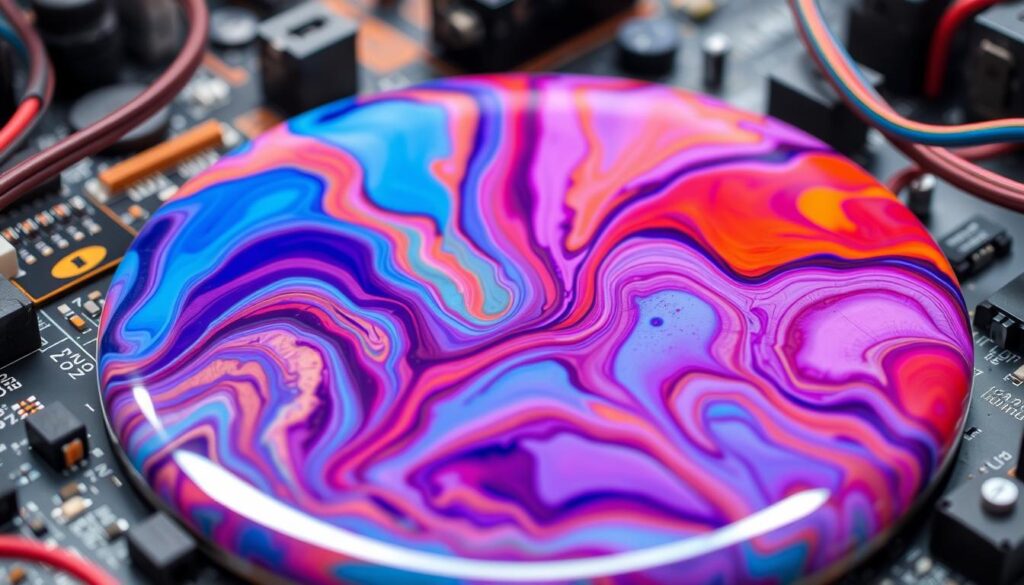
Dielectric Strength Properties of Potting Materials
To ensure effective electrical insulation and high voltage protection, it’s key to know the dielectric strength of potting materials. Dielectric strength is how much voltage a material can handle before it breaks down. This lets electricity flow. It shows what voltage a potting compound can keep out.
Testing dielectric strength means applying more and more voltage to a sample until it fails. This lets current flow. The voltage at failure is the dielectric strength, shown in volts per millimeter (V/mm) or kilovolts per millimeter (kV/mm). A higher dielectric strength means better insulation.
| Potting Material | Dielectric Strength (kV/mm) |
|---|---|
| Epoxy-based Compounds | 12 – 20 |
| Silicone Potting Materials | 16 – 24 |
| Polyurethane Potting Solutions | 10 – 18 |
The table shows silicone potting materials have the highest dielectric strength. They’re great for where you need top-notch electrical insulation and high voltage protection. Epoxy and polyurethane also offer great insulation, but their strengths vary based on how they’re made and cured.
“Choosing the right potting compound with the right dielectric strength is vital for high-voltage electronics and equipment to work well.”
Knowing the dielectric strength of different potting materials helps engineers and designers. They can pick the best for their projects’ electrical insulation and high voltage protection needs.
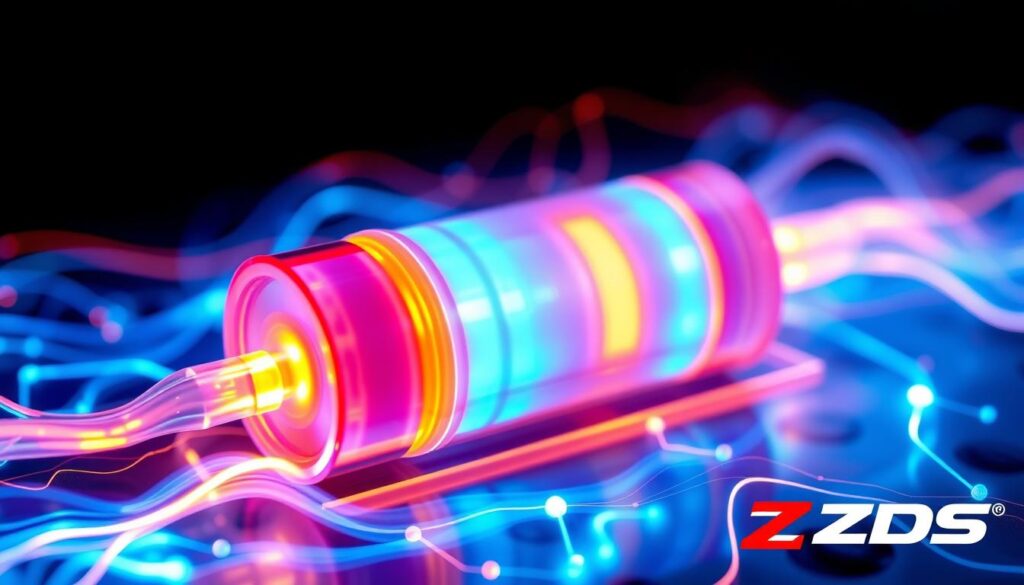
Temperature Effects on Voltage Insulation Capacity
Temperature is key to how well potting compounds work. They need to keep voltage insulation strong, no matter the temperature. This is vital for high-voltage electronics to work well in different places.
Heat Resistance Factors
Potting compounds must handle high heat without losing their insulation resistance. The material’s chemical makeup, molecular structure, and how tightly it’s crosslinked all matter. These things help it stay strong in heat.
Cold Temperature Performance
They also need to keep their voltage breakdown ratings in cold. It’s important for them to stay flexible and not crack in cold weather. This is key for places where it’s very cold.
Thermal Cycling Impact
Thermal cycling, or going through many temperature changes, is tough on potting compounds. They must be made and cured right to handle these changes. This keeps their insulation working well over time.
| Temperature Characteristic | Importance for Insulation | Key Factors to Consider |
|---|---|---|
| Heat Resistance | Maintaining insulation resistance at high temperatures | Chemical composition, molecular structure, crosslinking density |
| Cold Temperature Performance | Retaining voltage breakdown ratings in low-temperature environments | Formulation and curing process to prevent brittleness and cracking |
| Thermal Cycling Impact | Withstanding expansion and contraction cycles without compromising insulation | Proper material formulation and curing to ensure long-term stability |

By thinking about these temperature factors, makers can make potting compounds that last. They work well in tough environments for a long time.
Applications in High-Voltage Electronics
Potting glue insulation is key in protecting high-voltage electronics. It’s used in many areas needing high voltage protection. This includes power converters, transformers, medical devices, and military gear. It keeps sensitive parts safe and working well in tough spots.
In power electronics, potting glue keeps high-voltage circuits safe. It stops moisture, dust, and other harmful stuff from getting in. This is vital for keeping power converters, inverters, and other gear working right and safely.
Potting glue is also a big help in making transformers and inductors. These are key for moving power around efficiently. The glue gives strong insulation and helps keep the windings stable, reducing the chance of breakdown.
| Application | Voltage Range | Potting Compound Type |
|---|---|---|
| Power Converters | Up to 10 kV | Epoxy-based |
| Transformers | Up to 50 kV | Silicone-based |
| Medical Devices | Up to 5 kV | Polyurethane-based |
| Military Electronics | Up to 20 kV | Epoxy-based |
The need for better, smaller electronics is driving more use of potting glue. It’s a game-changer for high voltage protection. It’s essential for keeping important electronic systems safe and running smoothly in many fields.
Testing Methods for Voltage Insulation Properties
At ZDS™, we know how vital it is to check the voltage insulation of our potting compounds. We use a strict testing process to make sure our products are top-notch. This includes standard tests, quality checks, and making sure they work well.
Standard Testing Procedures
We follow well-known ASTM standards to test our compounds. We look at voltage breakdown ratings and insulation resistance. These tests help us see how well our materials can handle electricity.
Quality Assurance Measures
We also have special quality checks to make sure our compounds work well every time. We examine the materials we use, control the process, and check the final product. This way, we guarantee our customers get the best insulation from ZDS™.
Performance Verification
We test our compounds in real-world situations and under extreme conditions. This includes tests at different temperatures and with high electrical stress. Our detailed testing shows our products keep their insulation power over time.
At ZDS™, we aim to provide the best potting compounds for voltage insulation. Our careful testing and quality control mean our customers can trust our materials to perform well.
Environmental Factors Affecting Insulation Performance
When it comes to electrical insulation and potting glue, the environment matters a lot. Humidity, chemicals, and mechanical stress can all affect how well these materials work. These factors can change the insulation’s properties and how long it lasts.
Humidity is a big problem because it can make potting compounds lose their strength. If it’s too humid, the insulation can absorb moisture. This can make it less effective and increase the chance of electrical problems. To fight this, it’s important to pick materials that don’t let moisture in and to seal them well.
Chemicals can also harm potting glue insulation. In some places, there are chemicals that can damage these materials. It’s key to choose materials that can stand up to chemicals and to protect them from harm.
Mechanical stress is another issue. Things like vibrations or impacts can damage the insulation. To deal with this, it’s best to use materials that are strong and to add shock-absorbing parts.
| Environmental Factor | Potential Impact on Insulation Performance | Mitigation Strategies |
|---|---|---|
| Humidity | Moisture absorption, degradation of dielectric strength | Use of low-moisture-permeable potting materials, effective sealing techniques |
| Chemical Exposure | Corrosion, degradation of insulation properties | Selection of chemically resistant potting compounds, implementation of protective measures |
| Mechanical Stress | Cracking, deformation, degradation of insulation | Use of high-strength potting materials, incorporation of shock-absorbing mechanisms |
Knowing how the environment affects insulation and potting glue helps make better choices. This knowledge is key for keeping high-voltage systems safe and reliable, no matter where they are.
“Careful consideration of environmental factors is vital for the integrity and performance of high-voltage potting compounds. They are essential for protecting important electronic parts.”
Safety Standards and Compliance Requirements
High voltage protection and the voltage range of potting glue insulation are key. It’s important to follow safety standards and compliance requirements. This section covers international standards, industry regulations, and certification processes. These ensure the safe and effective use of these insulation materials.
International Standards
Global standards govern the voltage insulation properties of potting glue insulation. The International Electrotechnical Commission (IEC) sets guidelines for electrical insulation materials. Manufacturers must follow these standards to meet high voltage protection requirements.
Industry-Specific Regulations
Each industry has its own rules for potting glue insulation. For example, the automotive and aerospace sectors have unique standards. It’s important for manufacturers and users to stay updated with these regulations.
Certification Requirements
Potting glue insulation products need third-party certification to show compliance. This involves testing to verify performance, including voltage insulation and thermal stability. Certifications like UL or CE marking ensure the safety and reliability of these insulation solutions.
| Standard | Scope | Compliance Requirement |
|---|---|---|
| IEC 60664-1 | Insulation coordination for equipment within low-voltage systems | Mandatory for manufacturers of potting glue insulation used in low-voltage applications |
| UL 94 | Test for flammability of plastic materials for parts in devices and appliances | Required for potting glue insulation used in electrical and electronic devices |
| MIL-I-46058C | Insulating compounds, electrical, for coating printed circuit assemblies | Applicable for potting glue insulation used in military and aerospace applications |
By following these safety standards and compliance requirements, manufacturers and users can protect critical electronic components. This ensures the high voltage protection and optimal voltage range of potting glue insulation.
Conclusion
In this guide, we’ve delved into the world of potting glue insulation. It’s amazing at protecting electrical parts from high-voltage surges. We’ve covered the basics of its chemical makeup and the different voltage ratings of various compounds.
The main point is that potting glue can handle voltages from a few hundred to several kilovolts. This depends on the type of glue and the project’s needs. Things like dielectric strength, temperature resistance, and environmental factors are key in choosing the right glue.
Choosing the right potting glue ensures high-voltage electronics work safely and reliably. It meets strict standards and guidelines. Knowing how many volts can be insulated by potting glue insulation and its electrical insulation properties is vital. It helps make better products and keeps electrical safety at its best.
FAQ
What is the voltage range that can be insulated by potting glue insulation?
Potting glue insulation can handle a wide range of voltages. It works for both low-voltage electronics and high-voltage industrial uses.
How do the dielectric strength and insulation resistance properties of potting glue affect its voltage insulation capabilities?
The dielectric strength and insulation resistance of potting glue are very important. They help determine how well it can insulate against voltage. Compounds with higher values can handle higher voltages better.
What are the different types of potting compounds and their respective voltage ratings?
There are mainly three types of potting compounds: epoxy-based, silicone, and polyurethane. Epoxy-based compounds can handle the highest voltages. Silicone and polyurethane materials follow, but they are also effective.
How do environmental factors, such as temperature and humidity, impact the voltage insulation performance of potting glue?
Temperature and humidity can greatly affect how well potting glue insulates against voltage. Heat resistance, performance in cold temperatures, and how it handles thermal cycling are all important. These factors can change the insulation resistance and voltage breakdown ratings of potting compounds.
What safety standards and compliance requirements must be considered when using potting glue for voltage insulation?
When using potting glue for voltage insulation, it’s important to follow safety standards and regulations. These guidelines ensure the safe and effective use of potting compounds in high-voltage applications.


